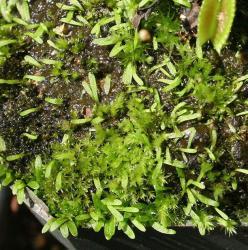About 10 weeks ago I received a Sarracenia c.v. 'Abandoned Hope' with two 10" pitchers, and a small Venus Flytrap, c.v. 'B-52' from California Carnivores.
The Sarracenia shipped in a 3.5" pot, and I'd like to move it to a 6" pot, or maybe a 11" bog pot—maybe along with the Venus flytrap. I suspect that the roots of these things are fragile and fibrous. Is it better to just plug the existing rootball intact into the new mix, or should I try to gently wash & tease some of the old peat mix away first?
Afterward, should I shade it for a week or so? It has a new pitcher developing which is about 8" tall and still mostly "flat" but starting to open at the tip, and a couple of others that are 1" and 3" tall. While these new pitchers have been developing, one of the older pitchers seems to be leaning over a little, as if it might be declining. (it's still firm and very solidly attached to the crown) Should I cut the "leaner" off to lessen transplant shock? Is trimming these even done? Humidity is fairly low here, with 55° nights, 75° days and bright, cloudless skies.
Also, there's a lot of greenery starting to cover the surface of the B-52's planting medium. At first, they consisted of just the smooth leaves, then the spiky growth emerged. Is this sphagnum moss? (for scale, the smooth leaves are about 1/4" long)


